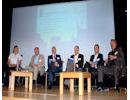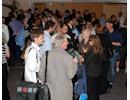British Library, London. 15 June 2009.
The Natural Capital Initiative and Science Council held an evening event in London to explore the concept of ‘greening’ a city. The event was supported by the British Library.
Taking London as the focus, the epitome of a modern, 21st century metropolis, our panellists explored what it means to be ‘green’. What does ‘greening London’ actually mean? How can we make sure that our cities are cosmopolitan and dynamic, meeting the needs of their population, while also ensuring that they are fit to meet the environmental challenges posed by a warming climate.
This event was targeted at early career researchers, NGOs, policy-makers and all those with an interest in the delivery of ecosystem services from our towns and cities, and in the future of urban development.
Podcasts of the panelists’ talks are available on the British Library website.
Before the event, our five speakers were asked the following:
- What is the biggest challenge facing sustainable urban development during the next ten years?
- How can science inform policy with respect to sustainable urban development?
Videos of each of the responses are available: Interviews with key speakers.
Our high-profile speakers presented their arguments to an audience of policymakers, urban designers, ecologists, students and members of the public.
Dr William Bird opened proceedings by reminding the audience of the health benefits of green spaces. This was a valuable way of contextualising the debate, giving the lie to any idea that green spaces are simply an abstract indulgence of the well-off, and instead clearly demonstrating that greening a city is a human welfare issue. Numerous studies have shown that when we see green areas and trees our blood pressure decreases, our heart rate drops and our brainwaves change to relaxed alpha waves. Studies have shown a clear link between obesity levels and areas with fewer green spaces. People live longer if they live by green spaces, though intriguingly, this effect is particularly noticeable amongst the poorest sectors of society. Green spaces can close the gap between rich and poor levels of health and life expectancy: greening cities is an important welfare issue.
Ken Livingstone, former Mayor of London, mentioned the great reformers of the Victorian Age who worked on disease, poverty and labour conditions, pointing out that these problems were largely solved in the cities. He argued that it is the same today, with 70-80% of the world’s carbon emissions coming from cities, leading to the conclusion that if we can achieve sustainable urban environments, we can solve climate change. He saw local power generation as an important factor in achieving this. As a high-profile politician with excellent networks, it was sad to hear him pessimistic about current efforts to combat climate change.
Peter Wilder outlined the need for ‘green infrastructure’, such as biofiltration systems, and a return to stewardship, whilst Malcolm Smith highlighted the fact that retro-fitting is the main answer when it comes to looking for solutions. Despite our attraction to the glamour and spectacle of the new, he argued that 95% of the city is out there already, and any meaningful solution has to be focused on the unsexy work of making existing homes and offices more sustainable.
Finally Lorna Walker argued that individual people are at the centre of any solution to greening a city, and that technological change cannot simply be relied upon. Rather, it is imperative to ensure that the population is engaged with anti-climate change measures. She added that in London we already have a great starting point from which we can lead by example: 37% of the capital is designated green space (and astonishingly, that figure does not include gardens), and there is plenty of potential for inspirational improvement given the right leadership.




